Complex Problems: Strategic Solutions
Introduction
Complex problem solving and strategic thinking provide a structure for distinguishing simple challenges from those that are more complex(Chevallier, 2016).A complex problem can be described as a question or concern that cannot be addressed using the routine or logical standard procedures (Proctor, 2005). To define and resolve challenges through traditional measures can prove demanding and therefore, exploring and redefining the problem will encourage the consideration for a variety of new perspectives. By re-evaluating what the problem is, allows for fresh observations that could then promote thought for new and creative solutions (Proctor, 2014).Furthermore, the ability to define problems quickly and accurately can prove crucial when trying to find the route cause. Finding the solution to a problem can then be addressed by providing additional training or redistributing the workload (Fisher et al., 2013). Throughout the activities both innovative and familiar techniques were introduced to enhance the Mechanical Training departments effectiveness and appetite for change, these would include brainstorming, mind mapping, force field analysis, the castle technique, plus/ minus/ interesting, system dynamics and other Project management techniques (Hicks, 2004; Higgins, 2006; Mullins, 2007, 2010; Proctor, 2010).
Theme A: Approaches to Problem Solving.
Activity 1a - Identifying complex problems.


Activity 1b - Identifying complex problems in your organisation.


Activity 2 - Systems Thinking
Seng, (2009) explains that Systems thinking defines and recognises the forces that shape the behaviours and interrelationships of organisations. This approach will align to a wider strategy to accommodate influences from the natural and economic environment. Furthermore, adopting a systems perspective or holistic approach, will allow for thinking of techniques to evolve and react to the internal and external forces placed upon them (Senge, 2009). Understanding systems from individual perspectives can offer tangible benefits which evaluate the management of change within a culture. Thorough an understanding of a department’s processes allows for a good insight into an individual’s decision making, this in turn will promote analysis and continuous improvement (Senge, 2009).Furthermore, Senge, (2009)suggests that without a Systems Thinking approach to a challenging subject, there can be a lack of real understanding as to why a problem continues to persist. By taking a holistic overview to a complex problem, the use of systems thinking techniques break down processes into singular components that can then be evaluated in isolation from the larger system (Senge, 2009).

Senior Managers and Planners have access to more information that affords them the ability to ‘zoom out’ to understand the relationships and intricacies of interrelating programmes, this allows stakeholders to consider other values and perspectives during times of decision making. This position will allow the planner to identify leverage points placed within a system that can be strategically timed or placed to promote change. By continually evaluating systems in this way provides the opportunities for new partnerships or external policy change, this will then advocate resources and promote collaboration. A personal mastery and understanding of a Systems workings will allow for an adjustment in reactive behaviours (Senge, 2009).According to Proctor (2014, 40) “A preference for thinking in new ways is a desirable feature of creative thought”. Learning and adapting from experiences is a beneficial function of progressive thinking, however, this approach can be slow and reactive. This tactic can fail to look and the long term systematic picture and pose a danger of ignoring gradual changes in circumstances external environment (Myers, et al, 2012).
The Armed forces have a rigid hierarchal structure that defines roles and responsibilities clearly. Hierarchal systems are designed to manage and understand the requisite as a whole and then disseminate the necessary information to match the resources to the characteristics of a situation (McWhinney, 1997). Hurst(1995) suggests that performance based organisations need to become adaptable and agile in order to respond to a crisis. Hurst (1995)developed eight steps to illustrate how systems respond to crisis by recreating themselves. This is comparable to the Armed Forces driving efficiencies to do more with less to meet the wider strategies of the organisation.
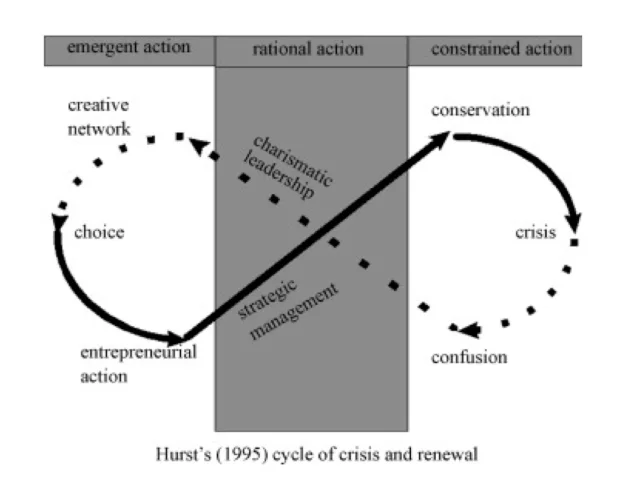
Hurst’s (1995) cycle of crisis and renewal argue that successful organisations evolve and renew to counter external forces being placed upon them. Management may also instigate “ethical anarchy” to initiate change or break negative cycles of a system that prevent the momentum of the wider strategy. Furthermore, Hurst (1995) explains that in spite of an organisations success it is still vulnerable to catastrophe Neff(2017)argues that the military has been historically resistant to change as it cultivates different barriers evident in the doctrinal rigidity and legacy force structures; these cultures and traditions have been preserved by a dominant culture. Consequentially, the elaboration or misuse of historical events can lead to an inability to learn from past mistakes. The integration of public and private sector within the Ministry of Defence now identifies with a Systems Thinking methodology as a progressive and essential tool for growth. The RAF identifies with systems thinking as illustrated in their recruitment campaigns seen in Annex A.
Activity 3- A model for Complex Problem Solving (CPS)
This activity explores a model for solving complex problems by using an alternative view of organisations and dividing an issue into four realities (McWhinney et al., 1997).The management of conflict in the work place is complex and requires a structured and balanced approach to adopt both practical and societal methods (Cottrell, 2011).McWhinney (1997) introduces a number of perspectives or belief systems that impact the way problem solving is addressed. The theory mode suggests that problems are addressed at a human level as people will all respond to differing tools and techniques according to their behaviours and individual characteristics. This framework is broken into four perspectives, unitary, sensory, mythical and social

Within an organisation the Mythic phase represents the long-term vision or outlook to capitalise on opportunities and ideas. The Unitary phase characterises the design of larger organisations by defining the framework policy, principles and discipline. Sensory; refers to the previous experiences and behaviours of the human resource,its employees and employers. The Social phase;caters and understands people’s purpose, values system and feelings(McWhinney, (1997).McWhinney’s (1997) modes of change, and a systems thinking approach gave an insight to why a problem persist and how to resolve it (Fischer et al., 2012)

McWhinney(1997) continues to address the distinctive modes of change and leadership styles by examining different approaches to change. These are analytic, assertive, influential, evaluate, inventive and emergent. By combining two modes of change, this creates a direction method that can be directly linked to figure 2 and used to assist with the generation of simple solutions to challenges. According to McWhinney, (1997) everybody is proficient in a number of modes, although, lean heavily towards a single reality through experience and routine. These distinctive modes derive from personal experiences. A weakness of McWhinney et al,. (1997) model is that individuals habitually prefer one mode from another and will therefore try to address every problem in the same way. Additionally the quality of leadership will factor as a strong leader will need to match their style, energy and other personal attributes to complement their co-workers and the presented problem.

Activity 4- Innovative and unusual models
Brainstorming SWOT &Mind Mapping
Commonly used within the Mechanical Transport Training
Brainstorming, SWOT analysis and Mind Mapping are all common recognised forms of creative thinking in conjunction with risk analysis. Brainstorming is an inclusive and creative activity that is fast and appealing however, Sutton and Hargadon, (1996) argue that this method will not always produce a quality solution. SWOT analysis (Strengths, Weaknesses, Opportunities and Threats) is another fast paced activity that’s function is to develop a full awareness of decision making factors (Fallon, 2017). Alternatively, Koch, (2000) argues that SWOT can be misused when justifying previous business decisions or a bias course of action. According to Buzan, (1994) “The structure of the mind map allows for intuitive associations, and then the capturing of thoughts within notes”.
TOWS(Threats Opportunities Weaknesses & Strengths)
Not commonly used within the Mechanical Transport Training
The department introduced Weihrich,(1982) TOWS matrix as an extension of a SWOT analysis, this would facilitate linkages in the data gathered from SWOT and present a structure for future strategies. This addition allows for combinations of processes to be studied by choosing strengths and opportunities that can be capitalised upon. See figure 5

Pareto Analysis Approach
The Pareto Analysis is a method also known as the “80/20 Rule” that suggests 20 percent of actual productivity generates 80 percent of the results Proctor (2014). This can be applied in a number of circumstances and provides only a guideline in principle. By identifying areas of improvement within an office environment the Pareto Analysis offers a different perspective. I.e. 80 percent of schedule delays result from 20 percent of inefficiencies. Or, 20 percent of the office deficiencies cause 80 percent of the problems Proctor, (2014).
GANTT charts and visual aids(APM 12 Steps)
This strategy defined tasks clearly within the department and distributed the resources evenly. The Gantt chart visually showed the extent of the work and highlighted interdependency of each task. Each individual project can be visually represented as a linear timeline Schedule(Lock, 2007). By following a clear structure, the team are able to identify the stages and direction of the project while identifying accountability within individual roles(Pinto, 1998).

Theme B: Working on a Real-Life Problem.
Activity 5 - Choosing your problem.










Activity 6 - Identifying the boundaries to the problem.

TEPIDOIL Analysis Defence Lines of Transport
The RAF recognises and utilises Defence Lines of Development to ensure they adopt a holistic approach to complex problem solving and capability integration. The Author was able to introduce this initially to examine the department for an external overview. This approach was extremely informative but failed to capture the detail required for a focussed complex problem (Dodccrp.org, 2019)
Training - The provision to practice, develop and validate, within constraints to deliver a military capability.
Equipment - The provision of military systems and weapons required to enable an individual, group or organization.
Personnel - The provision to motivate personnel to deliver outputs now and sustain for the future.
Infrastructure - The acquisition and development of all buildings, structures, land and utilities
Concepts and Doctrine - The principles in which military forces guide their actions and conduct themselves to order.
Organisation - Relates to the operational military force structures and relationships,
Information - The provision for the development of gathering information and knowledge.
Logistics - The provision for planning and carrying out the movement of forces. This includes the storage, transport and distribution of materiel and personnel.
SWOT Analysis
The SWOT Analysis is a fast paced recognisable tool within the training department. The Author chose this approach to stimulate interest and promote inclusion for all participants in order to generate initial momentum. The SWOT provided an initial structure to identify the department’s strengths, weaknesses, opportunities and threats (Proctor, 2014). However, the exercise identified a number of unexpected weaknesses that the Author had not considered previously.
Figure 6 shows a number of concerns that highlight the requirement for strong leadership backing this new proposal.

Activity 7 - Potential solutions to your problems.
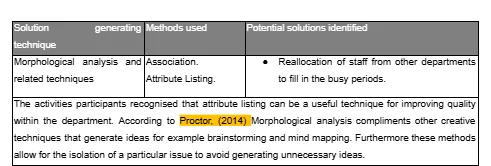


Summary
To ensure the success of this group’s activity, it was agreed by the department’s participants that the introduction of new ideas should be simplistic and familiar where possible. This collective group cohesion constituted a strong creative a learning organisation (Janasz et al., 2012). Surprisingly there were no negative individuals that hampered progress as all participants could understand the value in doing more with less. The introduction of techniques in short suggestion caused a slight overlapping that could have been avoided if the sessions had been staggered and less time restricted (Higgins, 2006).
Activity 8 - Identifying the likely constraints.
To understand if a project has been successful it can be measureable against three factors. Is it profitable? Has it arrived on time? And, has the project arrived under budget(Croft, 2018) Kay, (2016)?
Other considerations can expand the criteria such as adhering to governance, quality, functionality and customer satisfaction Pinto, (2013). Goldratt (1984) developed a Theory of Constraints (TOC) that suggests the majority of poor effects within an organisation derive from a few route causes. Constraints are necessary within systems to control exceeding outputs or reducing productivity to zero. Complex problems can be better understood by using Pinto’s, (2013) five steps to identify constraints

During activity 7, the participants highlighted a number of alternative solutions which were still bound by the same constraints as the original problem. The human resource, the availability of equipment and facilities and funding were all reoccurring themes. If one of these could be addressed then it would relieve a substantial portion of the stress placed upon the department (Mullins, 2007, 2010; Cameron and Green, 2012).
Manpower Cost
The unavailability of Manpower persists as the frequency of overseas deployments increases. Annual leave and mandatory external courses are also prioritised over the department’s training output. The required scaling for the Air Force assumes that all the staff are present without factoring in the additional commitments for example holidays and mandatory annual courses. Additionally, the instructor to student ratios are set by the Defence School of Transport which restricts the possibility of amalgamating courses in certain areas to reduce equipment and manpower running cost.
Quality
Without increasing the appropriately experienced instructional staff to meet the demand of the increasing workload, the department’s output and quality standards constitute as a constraint. To maintain standards and consistency set by the Defence School of Transport, instructional staff will need to be increased sufficiently to continue to deliver pre deployment training. An uplift in resource would allow for better lesson preparation and adaptation should any of the equipment, facilities or circumstances change.
Time
The allocation of time to each course is inflexible and has been set by the Defence School of Transport. Different courses require more or less focus depending on the student’s abilities and the complexities of the course content. This inflexibility acts as a constraint and impacts everybody involved (Cottrell, 2011). If the instructors had more flexibility to allocate time where required then certifying a student’s competency would allow the course to focus on areas which are more complex. The department suggested more flexibility be introduced into the courses timetables but senior management feared the system could be open to abuse. By revising the course time tables individually would not meet the standards required from the Defence School of transport.
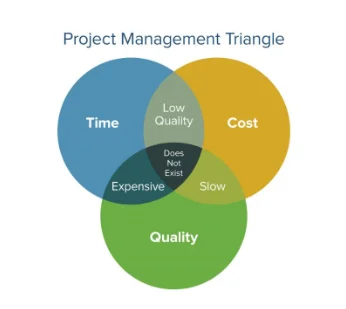
Summary
The department agreed that if one of the constraints was addressed on their own then another problem would appear elsewhere. For example, if the Time became flexible then the standards set by course design would not be met. Or, if the man power was increased sufficiently then the quality would likely increase however, the facilities and resources would still remain stretched. Although these areas were all examined by the department as a whole, the external factors placed upon the department were showing to only increase the discomfort on the department.
Activity 9 - Evaluation of potential solutions.
The department identified three potential solutions as a group activity. These solutions were then critically evaluated using techniques that would relate to the relevant audiences Customers, Managers, and Colleagues. All participants would have a different outlook on the training department’s deliverables.



Summary
The author chose the evaluation techniques to cater to the audience they would be delivered to. The process had to be easy to understand while delivering a progressive outcome (Proctor, 2014). These chosen processes were also chosen to ignite enthusiasm and creativity amongst the recipients. The author understood that all solutions had very specific constraints that would not allow for flex in the system at this time. However, evaluating three chosen solutions allowed the processes to run their course and recognise constraints.
Solution A opts to ‘do more with less’ while providing transparency to customers on the availability of courses and resources. To continue the working practices as they are will not be sustainable in the future as more instructors are deployed abroad.
Solution A has no financial impact or contest from external factors for resources
Activity 10 - Developing and using your implementation plan
By creating a checklist the intention is to provide a structure for implementing change to a complex problem (Hicks 2008).A strategic plan provides a high level over viewto identify the tools and resources for the project. Alternatively, the projects main plan will have a greater focus on the execution its detail. The project plan will examine what is required? How is it done? Who does what? And when things will happen? (Croft, 2018).
Adopting an analytical model will assist with the communication of strategy effectively to the department’s management (McWhinney, 1997).
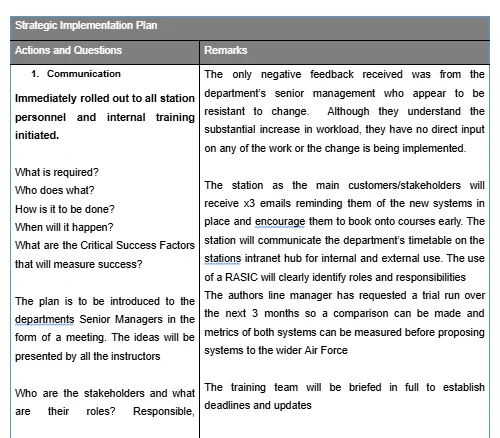



Summary
Using this implementation plan helped to create a high level checklist that would ensure the correct level of detail is captured during the change process. By creating a 5 step action plan for the instructors to follow reduced any conflict and improved the motivation and cohesion throughout. Furthermore, the Introduction of a RASIC chart removed any blurred lines around the service being delivered to the recipients.
Figure Nine: RASIC used to communicate a roles and responsibilities of stakeholders. Responsible, Accountable, Support, Informed, Consulted (Authors own diagram transposed from the departments terms of reference)
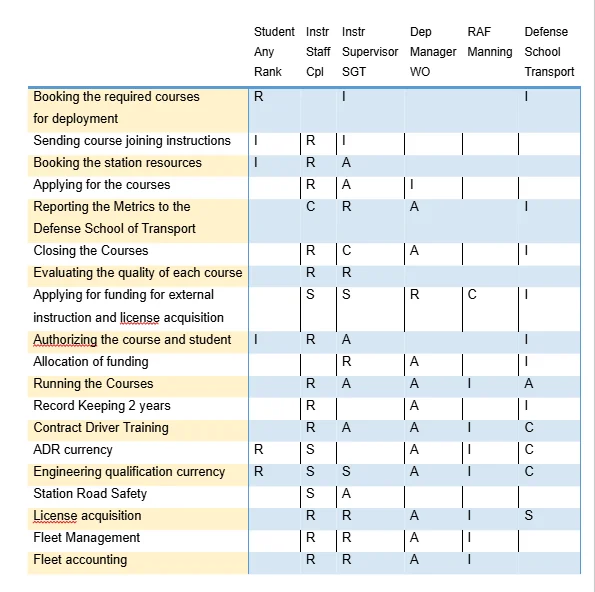
Activity 11 - Assessing and managing the risk in your implementation plan.
The training department as a learning organisation must critically evaluate its performance to ensure it continues to achieve its deliverables. This controlled approach will mitigate against risk and potential threats to the departments projects and therefore minimise their effects (Proctor, 2013). Accepting riskas part of a new strategy is inevitable and managing it with sufficient planning and stakeholder alignment will be fundamental measurement of a strategies success. Johson et al., (2005) suggests that planning for risk and containment within a new strategy ensure a systems perspective is maintained. During the departments initial planning stages, accuracy, brevity and accountability were encouraged to remove blurred lines and encourage proactive behaviours (Pinto, 2013). To clearly illustrate and visualise qualitative data Burke (2003) suggests using a probability vs impact matrix to convey an understanding of risk. Additionally, documenting risk visually could provide support when trying to identify potential difficulties. This visual aid will furthermore, communicate and evidence risk being evaluated and mitigated. The matrix in Figure 10 illustrates the impact of the departments reduced resources against the probability of occurrence.
Summary
The training department utilised the probability vs impact matrix to great effect and found it to be an excellent tool for communicating contingency planning to the management staff. Although the impact of a resource deficiency was understood by the department, the communicating of risk to operations had been overlooked by the management who based the department’s success on the number of students passing the minimum criteria rather than the confidence and competence of the servicemen being deployed.


Activity 12 - An evaluation of the external environment.
The external environment is primarily reflective of the implications of competitive rivalry in between different entities concerning particular objectives. The outcomes are most often marked by innovation based technological improvements which can be instantaneously related to technology intensive services such as the Royal Air Force. Beckhm et al,. (2017) has focused on the perspective that technical feasibility is of high significance and improvement of efficiency and operational quality could be an assistive strategy and not the core functional strategy which could be viable from any perspective. The determination of such strategic models is premised upon the precise performance of the PESTEL evaluation. Please refer to Appendix IV

Summary
The primary objective of sustaining the abilities to function and operate within any specific condition or situational implication, is the core constituent of the functional processes of each and every organisation. To this effect, the impacts of both the internal and the external conditions and the influences associated with such conditions could be recognised to be the catalysts for introducing changes within the operational framework of such organisations. Such changes are manifested through adaptation and evolution of working strategies by the concerned organisations. In this context, the process of identification of external influences of change involves the application of PESTEL analysis within involves the assessment of political, economic, sociological, technological, environmental and legal influences as well as their implications on the proposed solutions of any complex problem.
PESTEL Analysis
Annex F
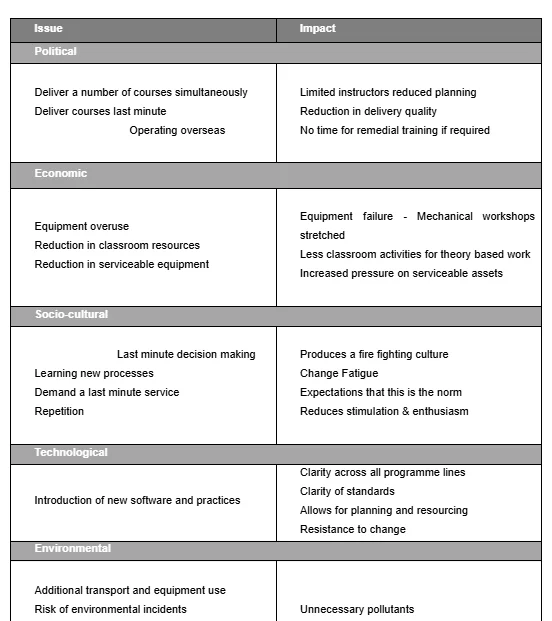
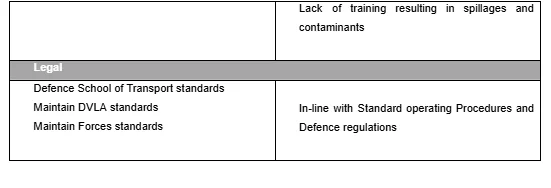
Activity 13 - Producing a critical evaluation
The critical evaluation process has involved the analytical understanding formulation of each of the previous activities. This process has included the identification of the actual complex problem in the Mechanical Transport Training Department as the underperformance due to constraints of availability of instructional staff and resources. The activity has been comprised by Identification of the complex problems with brief details of the characteristics of the problems and the reasoning of the problem having been selected as a complex one in the first place. The solution development then has explored the organisational behaviours through systems thinking so that the organisational dimensions, related to the problem, could be understood. The process then outlined the evaluation of the multiplicity of models of complex problem solving through exploring the four realities so that alternative views of the organisation under consideration could be acknowledged. This perspective was then extended through the evaluation of modes of change through which such activities could be performed. The activity of evaluation of available innovative models has been undertaken with the purpose of detailing their applicability in terms of addressing the problem associated with the Mechanical Transport Training Department of RAF. The evaluation of several models of problem assessment and solution generation has been undertaken to determine the commonality of application within the concerned department. Furthermore, the activity has progressed towards the selection of the problem so that the different realities associated with the problem could be outlined. One element of consideration has been to outline the focus of effort within the entire set of activities. The external and internal context of the problem have been analysed so as to identify the boundaries of the problem and to mark out the stakeholders and influent elements of the current conditions. The tools of analysis of the problem have been selected on purpose of highlighting the organisational resources which would have to be involved such as training processes, equipment, personnel and infrastructural assets as well as doctrinal concepts of operations, the internal and external conditions in the forms of PESTLE and SWOT analytical processes. The information derived from such analytical tools has been utilised to evaluate different solution generation techniques and in the identification of the potential solutions.
Activity 14 - Identifying values and their impact
According to Proctor (2014, 129) the study of William McWhinney, regarding the impact of personal values on the process of project management, could be utilised to highlight the directional methods which are influenced in-depth by the concepts of the researcher. McWhinney has specified that there are five different measures through which the influence of personal values could impact upon the proceedings of the projects of change management. These measures could be identified as the Modes of Change, Directional Methods, Basic Actions, Process based questions and Planning measures. In case of the change modes, the evaluative, inventive and emergent modes could be utilised. In case of the evaluative change mode, the elements of personal values, related to the social and sensory perceptions, formulate the basis on which the next measure of Basic Action could be elicited. This process involves determining preferences and meanings of self-perceived notions of value by any individual, under any particular situation. This could be further elaborated from the next measure of determination of what are the actual values which exist in such scenarios, both within the individuals under consideration and within the organisations for who these individuals could be operating. This further extends into the evaluation of the ranking process of values when such elements are multiple in number.

Summary
The problem solving process has been consistently forging new hurdles in terms of complication management which required application of different forms of solutions. Understandably, the process has brought forth different considerations of value based perspectives and the impact of the same on the overall problem solving process has been considerably extensive as well. The activity has been reflective of the personal reflections concerning the values of mine which I have and the impact of such values on my understanding of the solution generation of the complex problem of change management within the concerned department of the RAF. In this respect, the working values of facilitation maintenance for the subordinates and workgroups fostered the impact of having to rearrange the sessions of interactions between the training teams so as to strike a proper balance in between the increasing pressure and the necessity to evolve new working strategies. The review of my personal as well as the values of other has been indicative of the challenge of the maintenance of the overall efficacy of the departmental resources without having to jeopardise any of the qualitative requirements. The concentration of effort had been on the increment of the efficiency of the departmental staff.
Activity 15 - Ethical issues
The individual issue, concerning the author, has been related to the ethic of ensuring the select the most effective and suitable evaluation method for the problem of underperformance in the department and to also to ensure the effective deliverable so that progressive outcome could be ensured. This further involved the ethical responsibility to minimise strife and conflict of interest amongst the departmental personnel. This necessitated a strategy of solution development which could be readily comprehensible to all. Fostering of enthusiasm and creativity amongst the solution recipients has been another ethical issue where the possibility of flexibility introduction to the solutions has been next to none. The ethical issue of maintaining transparency has been another such aspect in light of the fact that the proposed solutions had particular constraints. Further ethical issues have comprised of ensure the sustainability of the solutions in the long term. However, this has been a drawback of the entire process of change management within the Mechanical Transport Training Department since the tailoring of the training courses to meet the students could not be performed now since the number of the customers exceeds the availability of resources for the department. This curbs the clarity and flexibility which could have been introduced to the design of planning processes earlier where training course flexibility had been possible Sutton and Hargadon, (1996).
Activity 16 - Applying ethical approaches
The rights based ethical approach has ensured that individuals have been provided with the opportunity to formulate their independent decisions. The moral rights which the solution development process participants have and the most suitable courses of action have all been determined by this approach.
The reflection on the clarity and ethical compatibility of the approaches has been the primary justice based ethical action performed in the solution development process. The element of fairness has been the core perspective in this regard.

Summary
The thinking has been to ensure the correct detailing of the aspects of the change process. The application of such approaches have also been utilised by the author so that the moral compass and associated values could not be called into question.
Activity 17 - Reviewing your thinking and decision making strategies
The strategic decision formulation has involved multiple phases of thinking. The first of these phases has been the initial analysis of the problem and the realisation of the different realities. Such realities have been the previously stated Unitary, Sensory, Mythic and Social perspectives. From these, the dominant perspective for the team work based solution development thinking was selected to be that of the combined Sensory and Mythic perspective which fostered inventiveness. The dominant organisational perspective was selected to be the combination of Mythical and Unitary perspectives and this culminated in the formulation of the Assertive perspective. In this context, the strategy of methodical thinking further involved the realisation of the internal as well as external context of the problem. This review of the entire strategic perception development took into consideration the factors of Organisational (RAF) Strategy in the form of operational success requirements, the objective of sustaining of the workforce elements in future and management of capacity improvement as well as delivering of the intended outcomes in an efficient manner. This format of thinking has been indicative of the formative approach through acknowledging the necessity to sustain and improve capability with limited resources. Furthermore, identification of the activities and personnel of the organisation and beyond the organisation who are affected and who affect the problem was performed so as to determine the specific components of the various dimensions of the problem which would have to be addressed by the proposed solutions. The decision to undertake such analytical tools application was premised on the perspective to determine the internal, external and resource based dynamics of the Mechanical Transport Training Department of the RAF. The development of the three potential solutions, involving the group activity based inclusion of customers, managers and process colleagues signified the strategic approach of catering to the audiences regarding the final development of the deliverables. The proposed solutions highlighted the strategy of parallel courses of actions through which a conclusive decision could be arrived at. This involved the improvement of existing departmental resources through revised management methods and through improved efficiency, delegation of responsibilities to more facilitative departments and the solution of greater resource acquisition. The tools of evaluation were selected on the notion of identification of the constraints associated with such decisions related to individual solutions and to finally determine the solution which could gain more traction amongst the audience. The selection of the checklist method to formulate the strategic plan implementation process has been reflective of the strategy to concentrate the necessary effort to identify the resources and tools through which the focussed execution of the plan could be achieved. This has been a phase based process of gradual development of decision making and strategic thinking.
Activity 18 - Reviewing the complex problem solving models and their application
In this context, the complex problem solving models were selected as Brainstorming SWOT &Mind Mapping, TOWS(Threats Opportunities Weaknesses & Strengths) and Pareto Analysis Approach and GANTT charts and visual aids(APM 12 Steps). Based on this evaluation of potential solutions, three specific implementations of the developed strategic solutions have been conceived. These have been the processes of revising the management tools and efficiencies, requesting greater number of instructional staff from Air Command Headquarters and Consider moving the department to another building on station with more facilities. The methods of the Castle Technique, the Force filed Analysis and the Plus Minus Interesting have been utilised to evaluate the utility of the three developed solutions (Higgins, 2006). The implementation process has taken into consideration the objectivity of resource management and creativity infusion to the solutions of this complex problem. Furthermore, the implementation plan has been proposed to be introduced to the Senior Managerial stuff through work meetings and the presentation has been delegated to the instructors. The supposed solutions also outlined the necessity to communicate the developed measures to all of the station personnel so that internal training could be initiated under the notion of the selected solution of revised utilisation of existing management tools and improvement of efficiency. This phase marked the implementation plan objective of extending output and quality enhancement through limited resources. This further led to the identification of resources and instituting accountability. The objective has been to successfully manage the expected resistance to some effects of such change. This has further involved the tracking of the progress of implemented measures through utilisation of parallel methods in a co-ordinated manner so that progress could be measured on a real time basis. The emphasis has been also on the mediation of conflicts in this regard. The contingency planning has been inclusive of the perspectives that such late training requests could be accommodated through either sending the trainee to another station if the courses could be available there or through admitting the student in place of any less prioritised student. The risk of having to accommodate such requests also has outlined the necessity to deliver training through the SGT departmental manager if other options could not be utilised. This could be envisaged to be one aspect of the plan implementation which could address the effect of the complex problem in a sustained manner though it could not be considered to be a paradigm effort by the department to address all of the contingencies. The availing of feedback reporting has been the final implementation process of the developed plan of solution implementation. Conflict avoidance amongst the instructors through 5 step strategic plan development has been reflective of clarity based decision making.
Annex C: RAF Ethos and Core Values (Royal Air Force, 2008, 2).

Annex A Recruitment Video from 2016 showing the Typhoon Eurofighter made up of various tools and office supplies to reinforce that all aspects of the RAF play an integral role

Annex C The Rank Structure of the Royal Air Force

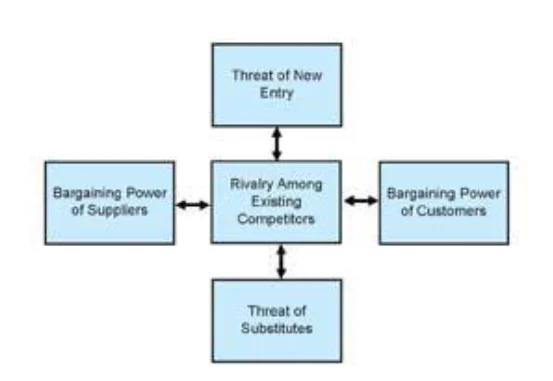
References
Asch, B. and Warner, J. (1994). A theory of military compensation and personnel policy. Santa Monica, CA: Rand, p.42.
Biron, C., Burke, R. and Cooper, C. (2016). Creating healthy workplaces. London: Routledge.
Carnall, C. (2007). Managing Change in Organizations. 5th ed. Essex: Pearson Education Limited, p.164.
Chevallier, A. (2016). Strategic thinking in complex problem solving. 1st ed. New York, NY: Oxford University Press.
Cline, W. (2007). Global warming and agriculture. Washington, D.C.: Institute for International Economics, p.1.
Ferraro, E. (2012). Investigations in the Workplace. 2nd ed. CRC Press, p.7.
Fisher, S. (2012). Working with conflict. Johanneshov: TPB.
Frensch, P. and Funke, J. (2006). Thinking and problem solving. 2nd ed. Saarbrücken: Universitäts- und Landesbibliothek.
García-Guiu, C., Moya, M., Molero, F. and Moriano, J. (2016). Transformational leadership and group potency in small military units: The mediating role of group identification and cohesion. Revista de PsicologíadelTrabajo y de las Organizaciones, 32(3), pp.145-152.
Glass, N. (1991). Pro-active management. 1st ed. London: Nicholas Pub., p.392.
House of Commons Committee of Public Accounts (2017). Skill shortages in the Armed Forces. London: House of Commons Committee of Public Accounts, p.10.
Kahugu, E. (2015). How To Successfully Introduce and Implement the Use of New Software in a Company. Master’s Degree in Health Care Health Business Management. Helsinki Metropolia University of Applied Sciences.
McWhinney, W. (1997). Creating paths of change. 2nd ed. Thousand Oaks, Calif.: Sage Publications, p.89.
McWhinney, W. (1997). Creating Paths of Change: Managing Issues and Resolving Problems in Organizations. 2nd ed. Calafornia: Sage Publications, p.89.
Myers, P., Hulks, S. and Wiggins, L. (2012). Organizational change. 1st ed. Oxford: Oxford University Press, p.180.
Pinto, J. (1998). Project management handbook. 2nd ed. California: Jossey-Bass Publishers, pp.181-183.
Rickards, T. (1985). Stimulating innovation. 1st ed. London: Frances Pinter, p.158.
Senge, P. (2009). The Fifth Discipline, The Art & Practice of the Learning Organisation. 1st ed. United States of America: Doubleday, pp.12-13.
- 24/7 Customer Support
- 100% Customer Satisfaction
- No Privacy Violation
- Quick Services
- Subject Experts



